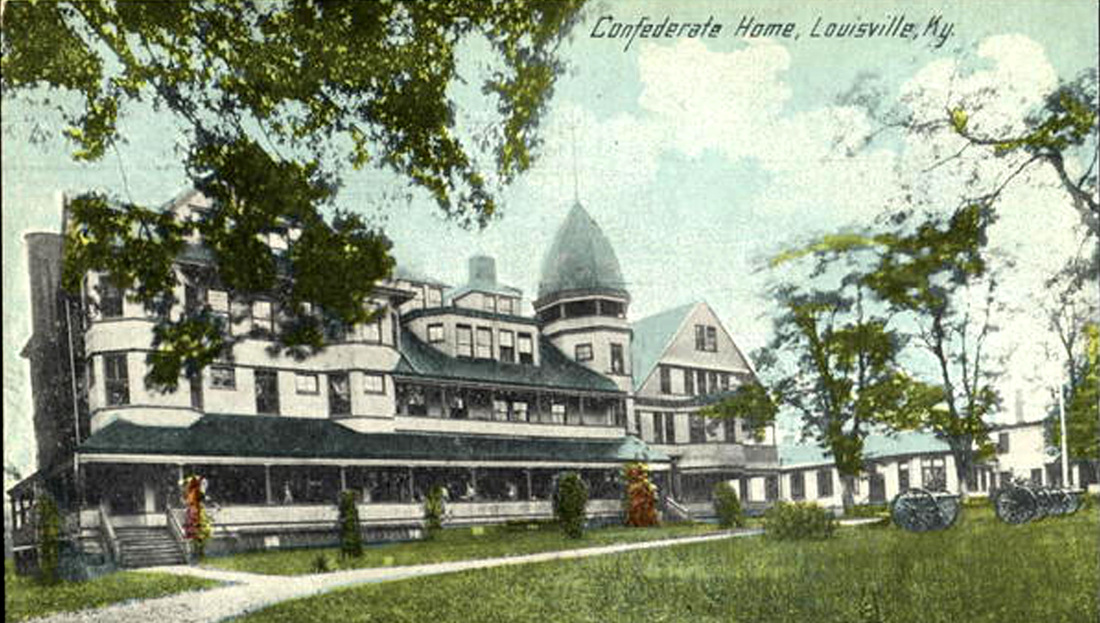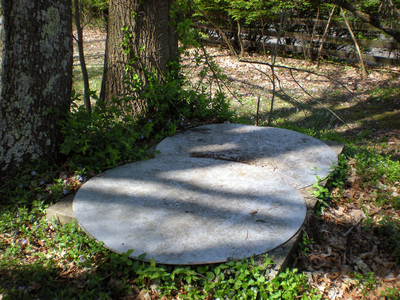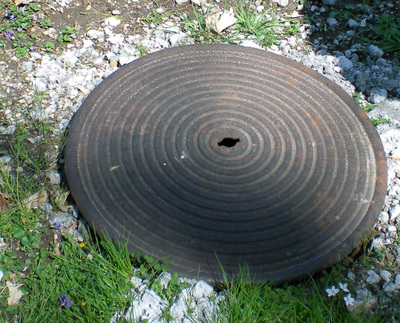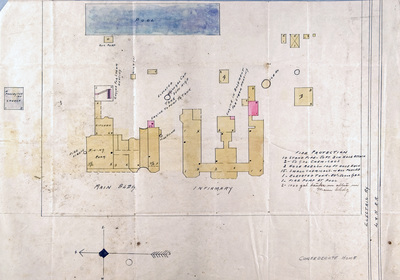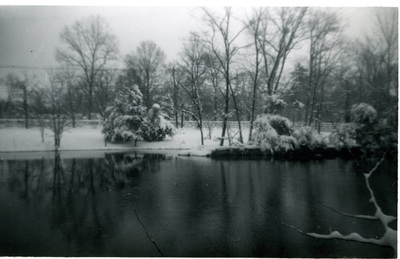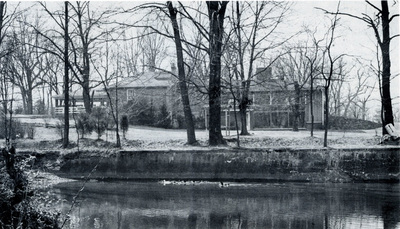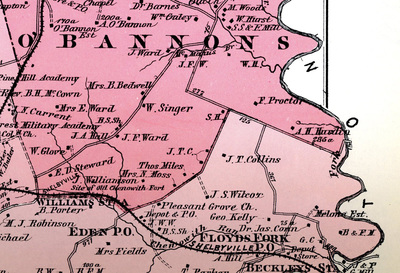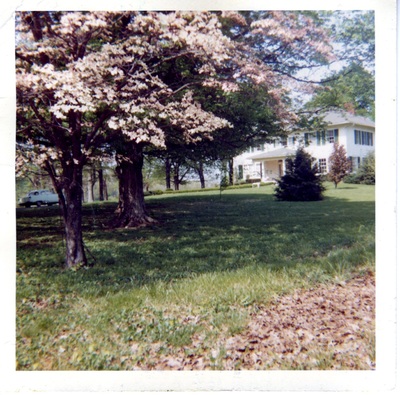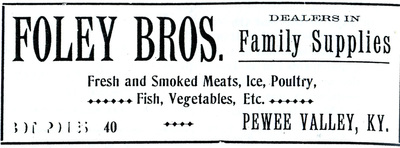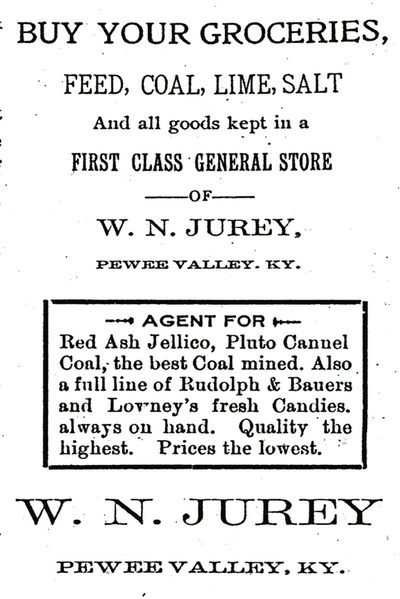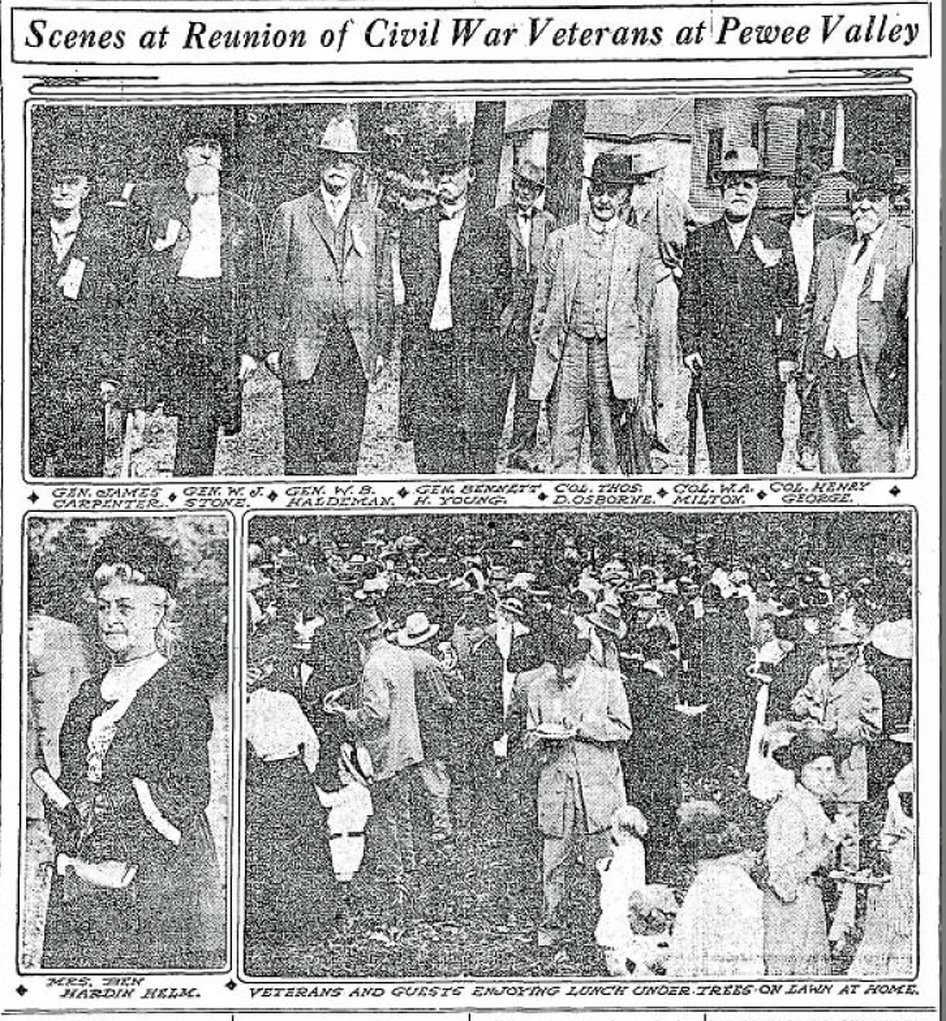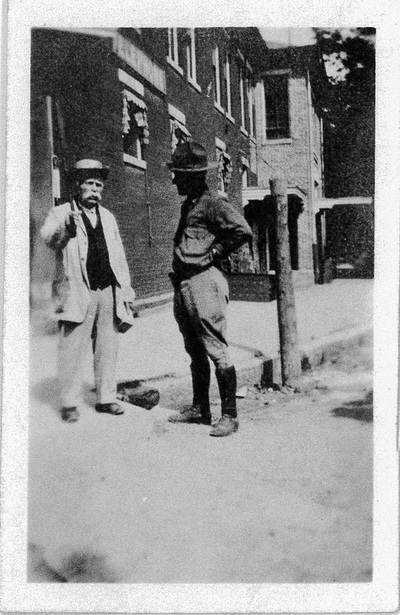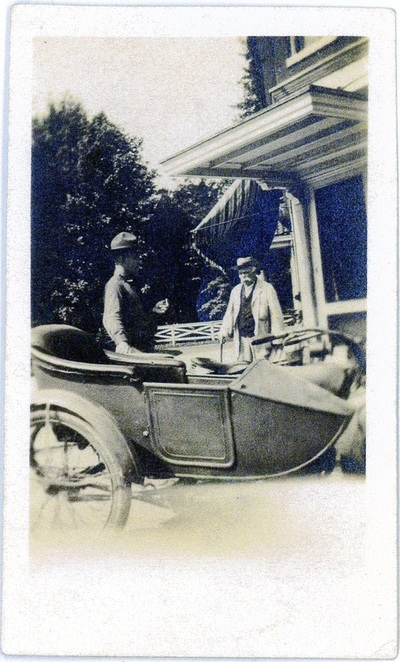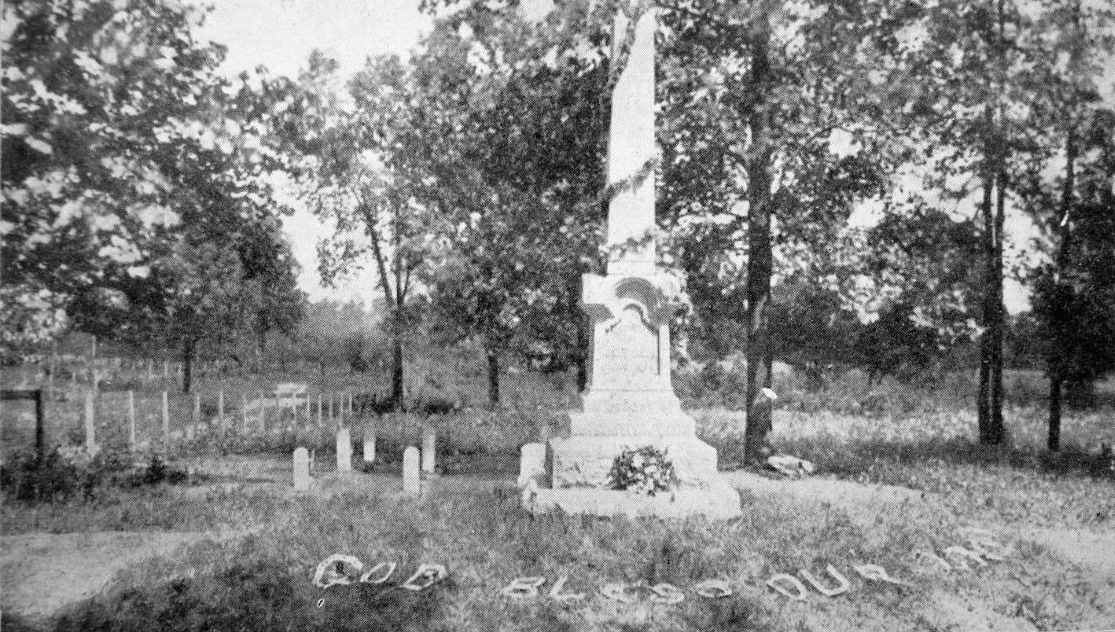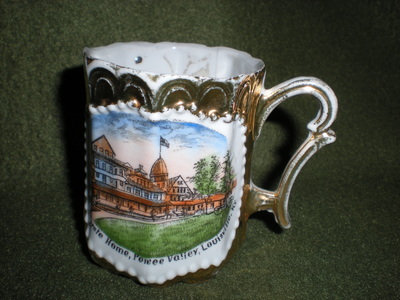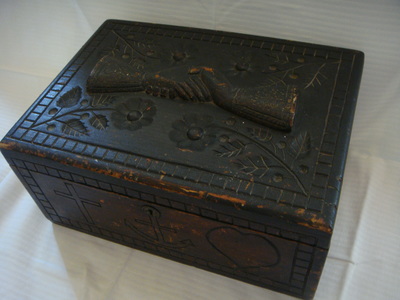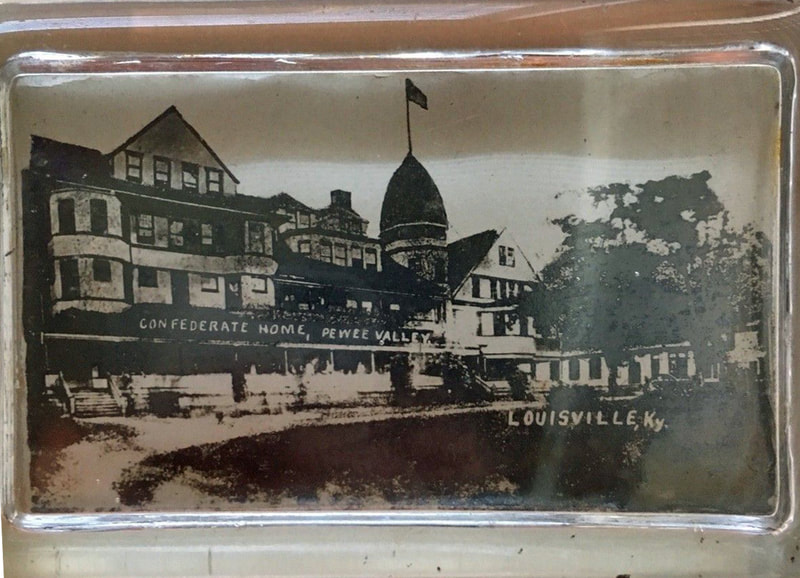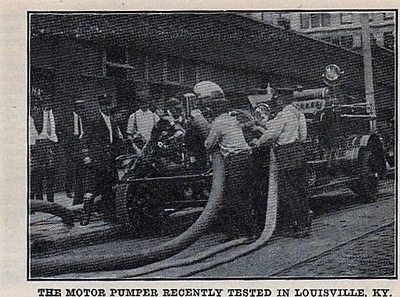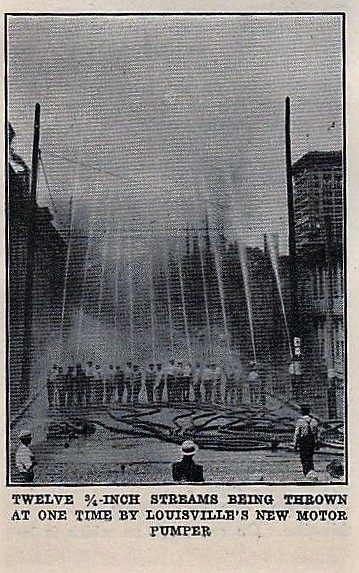Pewee Valley's Side of the Kentucky Confederate Home Story
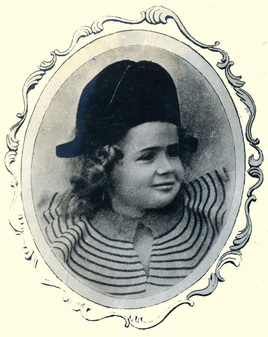 The real Little Colonel-- Pewee Valley resident Hattie Cochran. Photo by Kate Matthews.
The real Little Colonel-- Pewee Valley resident Hattie Cochran. Photo by Kate Matthews.
There was truth in the newspaper’s accusation, “There is too much aristocracy at Pewee Valley to permit poor and crippled Confederate veterans to be seen perambulating the place from day to day.”
At least some Peweeans must have shuddered at the thought of poverty-stricken veterans loitering on their picturesque streets. Peweeans were proud of their little town and were basking in the glow of author Annie Fellows Johnston’s charming depictions of Pewee or “Lloydsboro” Valley in her popular “Little Colonel” novels.
The Home’s size was also an issue. In the early 20th century, the town’s population was a little over 400. The Home was designed for 125 inmates and would later be expanded to house many more. Within the first three years of operation, the number of inmates ballooned to over 300. It nearly doubled the city’s population and would tax Pewee Valley’s resources to the limit.
At least some Peweeans must have shuddered at the thought of poverty-stricken veterans loitering on their picturesque streets. Peweeans were proud of their little town and were basking in the glow of author Annie Fellows Johnston’s charming depictions of Pewee or “Lloydsboro” Valley in her popular “Little Colonel” novels.
The Home’s size was also an issue. In the early 20th century, the town’s population was a little over 400. The Home was designed for 125 inmates and would later be expanded to house many more. Within the first three years of operation, the number of inmates ballooned to over 300. It nearly doubled the city’s population and would tax Pewee Valley’s resources to the limit.
Water shortages plagued the Home from the beginning, according to the July 1911 Confederate Home Messenger:
…Well after well has been sunk and while good water was found the quantity was so limited as to render no real service. Surface drainage was the only sure way of getting water. The drainage was quite limited and it comprised the grounds upon which the Home and Infirmary were located, and in the summer, the water became so tainted that its use became a menace to the health of the inmates.
In 1904, a 1,200,000 gallon reservoir was built, but the reservoir “had crevices which caused a constant leak,” said the Messenger. The old veterans often had to forgo bathing during the hot, humid summers. In 1910, the problem was resolved when the state allocated $8,500 to improve the reservoir and pipe water from a “never failing spring” in O’Bannons. “The Home has now the most complete and purest water supply of any State institution and it will cost the Home less than $200 a year to operate,” the Messenger crowed.
…Well after well has been sunk and while good water was found the quantity was so limited as to render no real service. Surface drainage was the only sure way of getting water. The drainage was quite limited and it comprised the grounds upon which the Home and Infirmary were located, and in the summer, the water became so tainted that its use became a menace to the health of the inmates.
In 1904, a 1,200,000 gallon reservoir was built, but the reservoir “had crevices which caused a constant leak,” said the Messenger. The old veterans often had to forgo bathing during the hot, humid summers. In 1910, the problem was resolved when the state allocated $8,500 to improve the reservoir and pipe water from a “never failing spring” in O’Bannons. “The Home has now the most complete and purest water supply of any State institution and it will cost the Home less than $200 a year to operate,” the Messenger crowed.
Solving the Water Shortage at the Kentucky Confederate Home Took Years
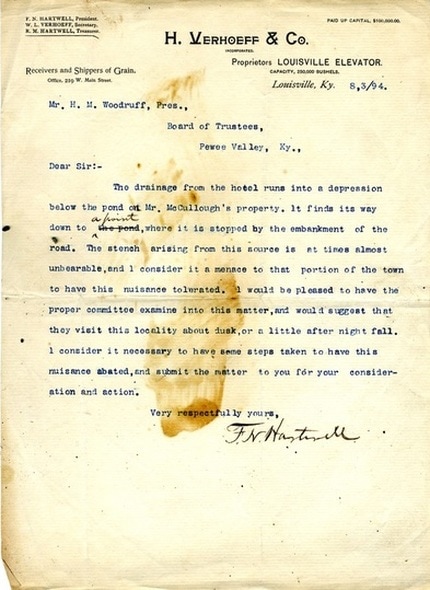 Ausut 3, 1894 letter from F.N. Harwell to Town Council President H.M. Woodruff complaining about the pond on the Villa Ridge Inn's property. From the City of Pewee Valley archives.
Ausut 3, 1894 letter from F.N. Harwell to Town Council President H.M. Woodruff complaining about the pond on the Villa Ridge Inn's property. From the City of Pewee Valley archives.
Sanitation was also a problem and had been a problem since the Villa Ridge Inn was built. The City of Pewee Valley's archives contain a letter Town Council President H.M. Woodruff received regarding the "almost unbearable" stench arising from the hotel's drainage into a pond by Muirs Lane on August 3, 1894.
Only a few years after the Home opened, Oldham County Attorney Horace McFarlan brought the water shortage and sewage issues at the Confederate Home to the Grand Jury and asked for an indictment against the facility. The March 19, 1905 Courer-Journal reported:
... Acting upon the result of an investigation of the condition of the Confederate Home at Pewee Valley, Horace McFarlan, County Attorney of Oldham County, pronounced he will present the case to the next grand jury, which meets March 27, and endeavor to secure an indictment against the home on the ground that it is a public nuisance because of its unsanitary conditions. ...The grand jury will be invited to visit the home and make a complete inspection...
... Pewee Valley has no water supply and the officers at the Home say they have done what they could to give the Home a water supply, and in that respect the Home is better off than any other building in Pewee Valley....
Dr. R. B. Cassedy, chairman of the County Board of Health, said yesterday that the board had recently made an examination of the premises, but that the report had not been drawn up and any statement as to the nature of the report would be premature. He said, however, that the board had found the drainage facilities not what they should be and that the reservoir which has just been completed and which will be filled by surface drainage is in such a position that water will flow through a stable and part over ground which will contaminate the water.
Horace McFarlan, the County Attorney, said..."The Board of Health found conditions unsanitary at the Home...For instance, the cuspidors are emptied out on the hillside, which runs down to the reservoir. Then there is a stable on the hillside that the Board of Health ordered removed a year ago and which has never been razed. It is manifest that water flowing over such places cannot possibly be pure ... Then a drainage pipe is run down several hundred feet from the building, and when the water supply from the reservoir is put into service, the drainage from this pipe will flow out over adjoining land. Will Ross and Mrs. Matilda Metz have protested against this on the ground that it will make their premises unsanitary...
... Col. Bennett H. Young, Chairman of the Board of Trustees,.... made the following statement:
"Ever since the location of the home at Pewee Valley there have been some people there who have done all in their power to annoy the management of the institution. When the home was run as a hotel, there was no complaint about sanitation, and exactly the same appliances for sewerage exist now as then. The pit is emptied twice a week at the cost of $80 per month.
"Pewee Valley has no means of sewerage, and the home is the only institution or place that removes its garbage and sewerage.
"Pigsties and outhouses are abundant, and these are not noticed, but every pretext is sought to lecture and criticize the Confederate Home.
"Pewee Valley has not water supply. Wells cannot be drilled to give sufficient water for the use of the home. Water could not be obtained at a depth less than 1,600 feet, and experts reported to the board that the water then found would be so impregnated with sulphur and salt as to render it perfectly useless. It could not be used for washing nor drinking nor even otherwise...
...The truth is that it is well know around Pewee Valley that Mr. McFarlan is a man with a grievance against the home... (Editor's note: this is an interesting assertion, since his wife was a member of the Reginald H. Thomas Chapter of the United Daughters of the Confederacy in LaGrange and his brother served as the home's engineer and later as its commandant during the final years it was open!)
While the water shortage was resolved in 1910, the sanitation issue was not -- at least to the neighbors' satisfaction. Some 15 years after the Kentucky Confederate Home opened, Annie L. Norwood, who owned a nearby farm, brought suit against the Home. According to the Southwestern Reporter, Volume 189 (St. Paul Publishing Company: 1917), the Home had been dumping sewage directly into a creek that flowed through her property, creating “such offensive odors that her home was uninhabitable and the value of her land destroyed.” Norwood lost her case under the doctrine of sovereign immunity. The state owned the property. There was no financial recourse available to her.
Only a few years after the Home opened, Oldham County Attorney Horace McFarlan brought the water shortage and sewage issues at the Confederate Home to the Grand Jury and asked for an indictment against the facility. The March 19, 1905 Courer-Journal reported:
... Acting upon the result of an investigation of the condition of the Confederate Home at Pewee Valley, Horace McFarlan, County Attorney of Oldham County, pronounced he will present the case to the next grand jury, which meets March 27, and endeavor to secure an indictment against the home on the ground that it is a public nuisance because of its unsanitary conditions. ...The grand jury will be invited to visit the home and make a complete inspection...
... Pewee Valley has no water supply and the officers at the Home say they have done what they could to give the Home a water supply, and in that respect the Home is better off than any other building in Pewee Valley....
Dr. R. B. Cassedy, chairman of the County Board of Health, said yesterday that the board had recently made an examination of the premises, but that the report had not been drawn up and any statement as to the nature of the report would be premature. He said, however, that the board had found the drainage facilities not what they should be and that the reservoir which has just been completed and which will be filled by surface drainage is in such a position that water will flow through a stable and part over ground which will contaminate the water.
Horace McFarlan, the County Attorney, said..."The Board of Health found conditions unsanitary at the Home...For instance, the cuspidors are emptied out on the hillside, which runs down to the reservoir. Then there is a stable on the hillside that the Board of Health ordered removed a year ago and which has never been razed. It is manifest that water flowing over such places cannot possibly be pure ... Then a drainage pipe is run down several hundred feet from the building, and when the water supply from the reservoir is put into service, the drainage from this pipe will flow out over adjoining land. Will Ross and Mrs. Matilda Metz have protested against this on the ground that it will make their premises unsanitary...
... Col. Bennett H. Young, Chairman of the Board of Trustees,.... made the following statement:
"Ever since the location of the home at Pewee Valley there have been some people there who have done all in their power to annoy the management of the institution. When the home was run as a hotel, there was no complaint about sanitation, and exactly the same appliances for sewerage exist now as then. The pit is emptied twice a week at the cost of $80 per month.
"Pewee Valley has no means of sewerage, and the home is the only institution or place that removes its garbage and sewerage.
"Pigsties and outhouses are abundant, and these are not noticed, but every pretext is sought to lecture and criticize the Confederate Home.
"Pewee Valley has not water supply. Wells cannot be drilled to give sufficient water for the use of the home. Water could not be obtained at a depth less than 1,600 feet, and experts reported to the board that the water then found would be so impregnated with sulphur and salt as to render it perfectly useless. It could not be used for washing nor drinking nor even otherwise...
...The truth is that it is well know around Pewee Valley that Mr. McFarlan is a man with a grievance against the home... (Editor's note: this is an interesting assertion, since his wife was a member of the Reginald H. Thomas Chapter of the United Daughters of the Confederacy in LaGrange and his brother served as the home's engineer and later as its commandant during the final years it was open!)
While the water shortage was resolved in 1910, the sanitation issue was not -- at least to the neighbors' satisfaction. Some 15 years after the Kentucky Confederate Home opened, Annie L. Norwood, who owned a nearby farm, brought suit against the Home. According to the Southwestern Reporter, Volume 189 (St. Paul Publishing Company: 1917), the Home had been dumping sewage directly into a creek that flowed through her property, creating “such offensive odors that her home was uninhabitable and the value of her land destroyed.” Norwood lost her case under the doctrine of sovereign immunity. The state owned the property. There was no financial recourse available to her.
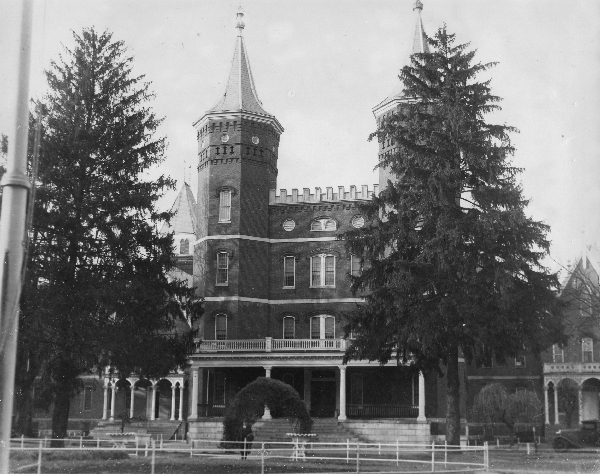 The Lakeland Asylum was located just a few miles from Pewee Valley in Anchorage.
The Lakeland Asylum was located just a few miles from Pewee Valley in Anchorage.
There was another good reason Peweeans feared living cheek by jowl with the Home’s inmates. Many already had first-hand experience with the hazards of living near Lakeland Asylum. Escaped lunatics were common in the valley. Johnston mentioned the problem in her 1907 novel, The Little Colonel’s Knight Came Riding, as did Fannie Casseday Duncan in this excerpt from her book, Jennie Casseday of Louisville: her intimate life as told by her sister, Mrs. Fannie Casseday Duncan:
"… Jennie …went to Rest Cottage (editor’s note: it was located in Pewee Valley on the site of Capt. Thomas Floyd and Blanch Weissinger Smith’s former farm) a week or so in advance of the opening of that summer Home so as to get rested before the girls came out. Her nurse and I went with her. One day her nurse asked to spend the night in town and Jennie gladly accorded the privilege. When bedtime came we were surprised to find that the woman who had been employed as a housekeeper had given the cook permission to spend the night out, and had herself left the home without leave….the Rest was located not far from a lunatic asylum and sometimes there were escapes from it and wanderers through the neighborhood…. I was consternated -- worse than that, frightened. I went to my frail little sister and said in despair: "What shall we do? You and I are alone in this house for the whole night. There is no house very near and if there were, I could not leave you to go for assistance. What can we do?"
Jennie gave me one of her gentle smiles and answered, "We can trust God. That's not so bad a thing to do, is it?" "Yes," I said, "but the lunatics…and the possibility of your sudden illness?"
"Do you think they are not also in God's hands?"
So we went to bed and Jennie went to sleep almost at once. But I was very wakeful until past midnight. In the morning, the colored man, who came early to do the milking, had a horrid report. He told me that at 4 in the morning a lunatic had got loose and came to Rest Cottage and danced right under Jennie's window in a wild sort of dance. He had on nothing but his cotton underdrawers and he had a big tin washpan on his head and a long iron flesh-fork in his hands. Searchers came and got him at daylight and took him back to the asylum. I was rather elated with this news and carried it at once to my sister's bedside. "Aha, Miss Trustful," I said, "let me tell you what happened last night and maybe you will not be so trustful again." And I told it all, adding such gruesome reflections as came to me.
"Were you frightened?" she asked.
"Frightened? No I did not know he was there or I would have been, sure."`
"Did the man hurt you or me?" she countered.
I had nothing more to say and Jennie closed the incident by quoting: "Except the Lord keep the city the watchman waketh in vain."
(Editor's note: Escapes from Lakeland Asylum/Central State Hospital continued well into the 20th century. One three-time escapee Monte Guess, who was criminally insane and had committed two murders, is buried in Pewee Valley Cemetery.)
The Home’s Board of Trustees tried hard to screen out bad apples. Applicants had to prove they weren’t “addicted to the excessive use of intoxicating liquors.” Drinking and the possession of alcohol were prohibited. The mentally disturbed were quickly carted off to Lakeland Asylum.
The proscription against alcohol use didn't stop the inmates from drinking, however. They simply sneaked off campus for a nip. To this day, residents report finding old whisky bottles whenever the creek that flows through the former Confederate Home property floods its banks.
During the four years the Messenger newsletter was published, several stories appeared about inmates dismissed for drunkenness or bad behavior. The July 1908 issue reported this hair-raising tale under the euphemistic headline, “AN UNFORTUNATE AFFAIR:”
At the early hour of five o’clock in the morning, Mr. John McCreary left his bed in an excited condition and taking an axe from a bracket, where it is kept in case of fire, went into the room of Mr. Ed. O’Brien and attacked Mr. O’Brien while asleep. The handle of the axe hitting the iron bed caused it to glance which probably saved Mr. O’Brien’s life.
Mr. O’Brien awakened and caught the handle while Mr. McCreary was hitting away at him, Mr. O’Brien calling for help. Mr. McCreary succeeded in cutting three slashes in Mr. O’Brien’s head, face and arm. Mr. Watkins, the Ass’t Commander, hearing the noise, went to Mr. O’Brien’s assistance and Mr. McCreary fled from the home.
Dr. R.B. Pryor, the Home Physician, was telephoned for and came in a very few minutes and dressed the wounds of Mr. O’Brien which were not serious.
Nothing more was heard of Mr. McCreary for several days when he wrote back from a distant town saying he regretted the affair and would leave that evening for Texas.
It was regarded by the management of the Home as a most dastardly attempt upon the life of Mr. O’Brien without any apparent cause, though he said he had been told that Mr. O’Brien accused him of stealing tobacco. This was denied by those accused of telling him, and the consensus of opinion is that he was, at least for the time, temporarily deranged.
A frightening incident occurred at The Beeches after Annie Fellows Johnston purchased it in 1911, according to Iva Barbee Morse. A discombobulated inmate entered the home uninvited, when Annie was alone. She was standing at the top of the stairs when he entered. Her stepdaughter, Mary, arrived home just in time to grab the old veteran by his shirt collar and force him out the door. Pewee Valley’s women had to be self-reliant in those days. Widows and spinsters made up a significant share of the population. Most of the men worked during the day in Louisville.
Another was recounted by John Hewitt Barnett in "Early Days of Pewee Valley... founding fathers, heroic mothers and old soldiers" by Paul Gottbrath of the Courier-Journal (date unknown):
... A common sight on the streets of Pewee Valley during the early days of the century were Confederate "Vets," the survivors of the nation's civil war fifty years earlier. They walked down from their home, the Kentucky Confederate Home (formerly the Villa Ridge Inn) to lounge in the town's shops and exchange wild stories about the war.
"You'd almost always see 12 or 15 of 'em walkin' around the streets of Pewee Valley, telling stories, arguing with each other," recalls John Hewitt Barnett, a longtime resident of the area. "Sometimes they'd do more than argue; I remember several times them lashing out with their canes at each other."
Barnett recalls at least one instance when a dispute between two of the old soldiers went beyond canes. "One old guy had it in for another resident of the home for a long time, and he decided he was going to fix him once and for all," Barnett said. "So he sent off to a mail order house for a gun, which he smuggled into the home. One day the two men got to arguing again about something and this one old guy pulls out the gun and shoots the other. I don't think it killed him but it sure surprised the staff there and they kept a closer eye on the old boy who did the shooting..."
"… Jennie …went to Rest Cottage (editor’s note: it was located in Pewee Valley on the site of Capt. Thomas Floyd and Blanch Weissinger Smith’s former farm) a week or so in advance of the opening of that summer Home so as to get rested before the girls came out. Her nurse and I went with her. One day her nurse asked to spend the night in town and Jennie gladly accorded the privilege. When bedtime came we were surprised to find that the woman who had been employed as a housekeeper had given the cook permission to spend the night out, and had herself left the home without leave….the Rest was located not far from a lunatic asylum and sometimes there were escapes from it and wanderers through the neighborhood…. I was consternated -- worse than that, frightened. I went to my frail little sister and said in despair: "What shall we do? You and I are alone in this house for the whole night. There is no house very near and if there were, I could not leave you to go for assistance. What can we do?"
Jennie gave me one of her gentle smiles and answered, "We can trust God. That's not so bad a thing to do, is it?" "Yes," I said, "but the lunatics…and the possibility of your sudden illness?"
"Do you think they are not also in God's hands?"
So we went to bed and Jennie went to sleep almost at once. But I was very wakeful until past midnight. In the morning, the colored man, who came early to do the milking, had a horrid report. He told me that at 4 in the morning a lunatic had got loose and came to Rest Cottage and danced right under Jennie's window in a wild sort of dance. He had on nothing but his cotton underdrawers and he had a big tin washpan on his head and a long iron flesh-fork in his hands. Searchers came and got him at daylight and took him back to the asylum. I was rather elated with this news and carried it at once to my sister's bedside. "Aha, Miss Trustful," I said, "let me tell you what happened last night and maybe you will not be so trustful again." And I told it all, adding such gruesome reflections as came to me.
"Were you frightened?" she asked.
"Frightened? No I did not know he was there or I would have been, sure."`
"Did the man hurt you or me?" she countered.
I had nothing more to say and Jennie closed the incident by quoting: "Except the Lord keep the city the watchman waketh in vain."
(Editor's note: Escapes from Lakeland Asylum/Central State Hospital continued well into the 20th century. One three-time escapee Monte Guess, who was criminally insane and had committed two murders, is buried in Pewee Valley Cemetery.)
The Home’s Board of Trustees tried hard to screen out bad apples. Applicants had to prove they weren’t “addicted to the excessive use of intoxicating liquors.” Drinking and the possession of alcohol were prohibited. The mentally disturbed were quickly carted off to Lakeland Asylum.
The proscription against alcohol use didn't stop the inmates from drinking, however. They simply sneaked off campus for a nip. To this day, residents report finding old whisky bottles whenever the creek that flows through the former Confederate Home property floods its banks.
During the four years the Messenger newsletter was published, several stories appeared about inmates dismissed for drunkenness or bad behavior. The July 1908 issue reported this hair-raising tale under the euphemistic headline, “AN UNFORTUNATE AFFAIR:”
At the early hour of five o’clock in the morning, Mr. John McCreary left his bed in an excited condition and taking an axe from a bracket, where it is kept in case of fire, went into the room of Mr. Ed. O’Brien and attacked Mr. O’Brien while asleep. The handle of the axe hitting the iron bed caused it to glance which probably saved Mr. O’Brien’s life.
Mr. O’Brien awakened and caught the handle while Mr. McCreary was hitting away at him, Mr. O’Brien calling for help. Mr. McCreary succeeded in cutting three slashes in Mr. O’Brien’s head, face and arm. Mr. Watkins, the Ass’t Commander, hearing the noise, went to Mr. O’Brien’s assistance and Mr. McCreary fled from the home.
Dr. R.B. Pryor, the Home Physician, was telephoned for and came in a very few minutes and dressed the wounds of Mr. O’Brien which were not serious.
Nothing more was heard of Mr. McCreary for several days when he wrote back from a distant town saying he regretted the affair and would leave that evening for Texas.
It was regarded by the management of the Home as a most dastardly attempt upon the life of Mr. O’Brien without any apparent cause, though he said he had been told that Mr. O’Brien accused him of stealing tobacco. This was denied by those accused of telling him, and the consensus of opinion is that he was, at least for the time, temporarily deranged.
A frightening incident occurred at The Beeches after Annie Fellows Johnston purchased it in 1911, according to Iva Barbee Morse. A discombobulated inmate entered the home uninvited, when Annie was alone. She was standing at the top of the stairs when he entered. Her stepdaughter, Mary, arrived home just in time to grab the old veteran by his shirt collar and force him out the door. Pewee Valley’s women had to be self-reliant in those days. Widows and spinsters made up a significant share of the population. Most of the men worked during the day in Louisville.
Another was recounted by John Hewitt Barnett in "Early Days of Pewee Valley... founding fathers, heroic mothers and old soldiers" by Paul Gottbrath of the Courier-Journal (date unknown):
... A common sight on the streets of Pewee Valley during the early days of the century were Confederate "Vets," the survivors of the nation's civil war fifty years earlier. They walked down from their home, the Kentucky Confederate Home (formerly the Villa Ridge Inn) to lounge in the town's shops and exchange wild stories about the war.
"You'd almost always see 12 or 15 of 'em walkin' around the streets of Pewee Valley, telling stories, arguing with each other," recalls John Hewitt Barnett, a longtime resident of the area. "Sometimes they'd do more than argue; I remember several times them lashing out with their canes at each other."
Barnett recalls at least one instance when a dispute between two of the old soldiers went beyond canes. "One old guy had it in for another resident of the home for a long time, and he decided he was going to fix him once and for all," Barnett said. "So he sent off to a mail order house for a gun, which he smuggled into the home. One day the two men got to arguing again about something and this one old guy pulls out the gun and shoots the other. I don't think it killed him but it sure surprised the staff there and they kept a closer eye on the old boy who did the shooting..."
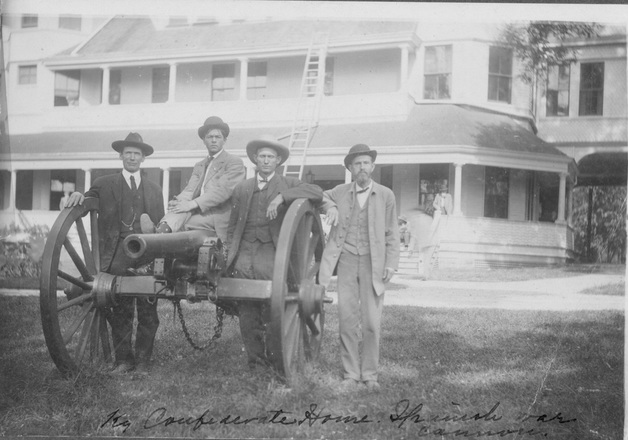 Mary Craig Lawton, the widow of General Henry Lawton, may have helped secure cannons from the Spanish-American War for the Kentucky Confederate Home. Blank charges were fired every morning at 6 a.m. to awaken the inmates. Photo from Kentucky Historical Society.
Mary Craig Lawton, the widow of General Henry Lawton, may have helped secure cannons from the Spanish-American War for the Kentucky Confederate Home. Blank charges were fired every morning at 6 a.m. to awaken the inmates. Photo from Kentucky Historical Society.
Once the Home opened, some community members welcomed the inmates. Ministers at the Pewee Valley Presbyterian and St. James Episcopal churches were among a group of local clergy who took turns conducting Sunday afternoon services at LZ Duke Hall.
The Craig women at Edgewood
performed many small acts of kindness. School marm Fannie played the piano for the men, while her mother, Annie, sent plants in honor of General Lee’s birthday. Fannie’s sister, Mamie Lawton, who built The Beeches after her husband, General Henry Ware Lawton, was killed in the Spanish-American War, sang on one occasion. Mrs. Blackley at Undulata was active in the Home’s United Daughters of the Confederacy chapter.
Vacationing women from the Jennie Casseday Rest Cottage came to visit, the young ladies of the Presbyterian Church put on a play at the Home, and Pewee Valley school children also entertained the inmates.
At the turn of the 20th century, people believed that mineral water possessed potent healing properties. Well-to-do Louisvillians and Peweeans traveled to spas in Indiana, such as French Lick and Martinsville Springs, for their health. Confederate Home inmates couldn’t afford such fashionable resorts, but they could imbibe all the mineral water they wanted for free in Pewee Valley, says Iva Barbee Morse. “…the Russells owned a property that had a spring with wonderful water….A lot of old soldiers took it in jugs back to the Home. They could go to it, drink it, get whatever they wanted,” she remembers.
The Craig women at Edgewood
performed many small acts of kindness. School marm Fannie played the piano for the men, while her mother, Annie, sent plants in honor of General Lee’s birthday. Fannie’s sister, Mamie Lawton, who built The Beeches after her husband, General Henry Ware Lawton, was killed in the Spanish-American War, sang on one occasion. Mrs. Blackley at Undulata was active in the Home’s United Daughters of the Confederacy chapter.
Vacationing women from the Jennie Casseday Rest Cottage came to visit, the young ladies of the Presbyterian Church put on a play at the Home, and Pewee Valley school children also entertained the inmates.
At the turn of the 20th century, people believed that mineral water possessed potent healing properties. Well-to-do Louisvillians and Peweeans traveled to spas in Indiana, such as French Lick and Martinsville Springs, for their health. Confederate Home inmates couldn’t afford such fashionable resorts, but they could imbibe all the mineral water they wanted for free in Pewee Valley, says Iva Barbee Morse. “…the Russells owned a property that had a spring with wonderful water….A lot of old soldiers took it in jugs back to the Home. They could go to it, drink it, get whatever they wanted,” she remembers.
Pewee Valley Stores Advertised in the Confederate Home Messenger
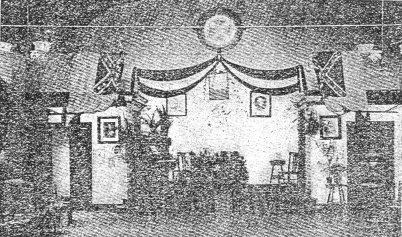 Duke Hall was filled with relics of the war and became a sort of Civil War museum, attracting many visitors.
Duke Hall was filled with relics of the war and became a sort of Civil War museum, attracting many visitors.
W.N. Jurey advertised his wares in many issues of the Messenger, as did the Foley Brothers. Both businesses were benefiting from the trade not only with the inmates, but with the hundred-plus visitors who came to the Home every month -- and many more when the home was the site of special events, such as CSA reunions. Those visitors provided Pewee photographer Kate Matthews with a much larger market for her souvenir “Little Colonel” picture postcards, too -- to the direct benefit of the Pewee Valley Presbyterian Church, which often used them as fundraisers.
Confederate Veteran Reunions Brought Many Extra Visitors to Pewee Valley
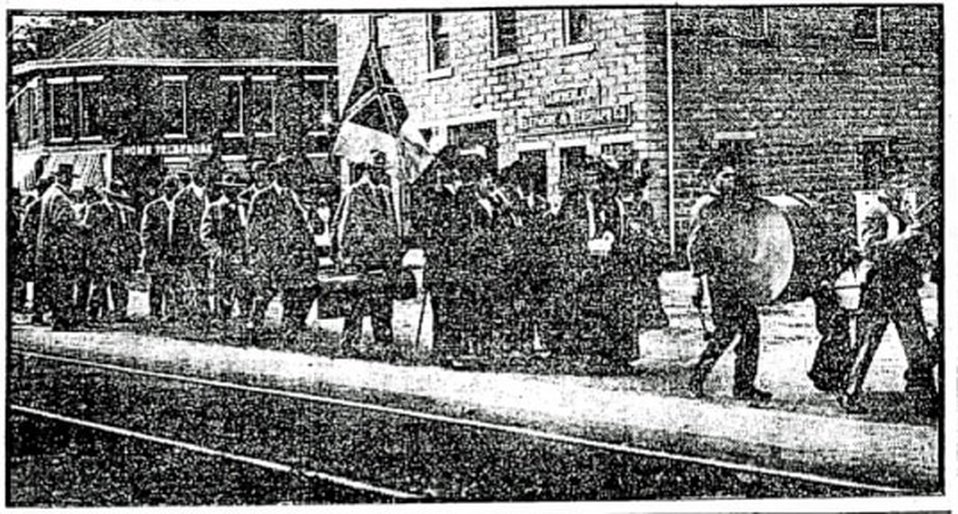
This photo from the October 17, 1914 Courier-Journal shows CSA veterans marching down Railroad Avenue in Pewee Valley. Between 400 and 500 veterans and members of the United Daughters of the Confederacy were in town for the annual reunion of the Kentucky Division of the United Confederate Veterans. Foley Bros. and Jurey's stores are both visible in the background.
Peweeans also took advantage of the large supply of cheap labor the Home brought to town. In an address given to the Oldham County Historical Society on May 31, 1974, Twigmore owner Lillian Fletcher Brackett, recalled, “… Every house had its old Confederate soldier, or so it seemed to us. He pumped water, did small gardening jobs and raking for tobacco money …” Louise Herdt "Sis" Marker recalled that a Confederate Home inmate was responsible for carting the incoming mail from across the tracks to the little post office building on Central Avenue, after it was kicked off the train.
Kentucky Confederate Home Inmates Were a Familiar Sight on Pewee Valley's Streets
Some inmates, such as John Thomas Laws, even babysat for local children. according to this anecdote published in My Old Confederate Home: A Respectable Place for Civil War Veterans by Rusty Williams (University of Kentucky Press, 2010):
...William and Ada Herdt's youngest daughter, Virginia, was born in 1921, and the little girl grew up surrounded by the old men in their gray uniforms. The Herdts operated the Herdt Motor Company, building wagons and repairing engines, and Home inmates regularly stopped by the shop for an idle visit or to pick up a part for the commandant...Every house in Pewee Valley, it seemed, had its favorite veteran...The Herdts had John Thomas Laws of Louisville, a ninety-year-old former sergeant of the Second Kentucky Infantry, Company K.
"'Uncle Tom,' we all called him," Gin recalled. "He was like a member of the family."
Tall, gentle Uncle Tom Laws spent time in the Herdt home doing errands and, now and then, babysitting Gin and the other Herdt children while their parents took some time away. Tom also helped at the wagon shop, occasionally driving into Louisville with William to deliver a job or pick up a part...
At least one played Santa Claus for the daughter of St. James Episcopal rector Rev. McAllister:
Inside the house (rectory) was a large foyer, barely furnished, but boasting a piano, where we all sang as Mother played….And I will never forget looking down into it from the stairway and seeing my first and greatest Santa Claus, sitting in the corner to the left of the door. A real snowy beard descended over his chest, and his belly really shook when he laughed. Best of all, he seemed to know ME. I couldn’t believe it. Years later I found out is was OLD BEN TURPIN, my favorite soldier at the Confederate Home. (Source: Thomas Brown, "A Brief History of the Episcopal Parish in Pewee Valley, Kentucky, Part II, 1870-1932 A.D." )
...William and Ada Herdt's youngest daughter, Virginia, was born in 1921, and the little girl grew up surrounded by the old men in their gray uniforms. The Herdts operated the Herdt Motor Company, building wagons and repairing engines, and Home inmates regularly stopped by the shop for an idle visit or to pick up a part for the commandant...Every house in Pewee Valley, it seemed, had its favorite veteran...The Herdts had John Thomas Laws of Louisville, a ninety-year-old former sergeant of the Second Kentucky Infantry, Company K.
"'Uncle Tom,' we all called him," Gin recalled. "He was like a member of the family."
Tall, gentle Uncle Tom Laws spent time in the Herdt home doing errands and, now and then, babysitting Gin and the other Herdt children while their parents took some time away. Tom also helped at the wagon shop, occasionally driving into Louisville with William to deliver a job or pick up a part...
At least one played Santa Claus for the daughter of St. James Episcopal rector Rev. McAllister:
Inside the house (rectory) was a large foyer, barely furnished, but boasting a piano, where we all sang as Mother played….And I will never forget looking down into it from the stairway and seeing my first and greatest Santa Claus, sitting in the corner to the left of the door. A real snowy beard descended over his chest, and his belly really shook when he laughed. Best of all, he seemed to know ME. I couldn’t believe it. Years later I found out is was OLD BEN TURPIN, my favorite soldier at the Confederate Home. (Source: Thomas Brown, "A Brief History of the Episcopal Parish in Pewee Valley, Kentucky, Part II, 1870-1932 A.D." )
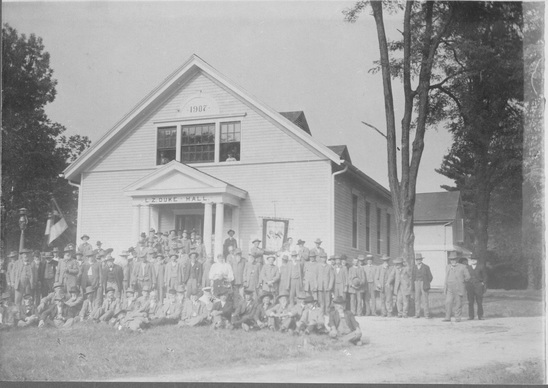 L.Z. Duke Hall was the recreational facility on the home's campus. It was where local ministers held Sunday services for the inmates and, once it had electricity, showed movies to Peweeans and inmates alike. Photo from the Kentucky Historical Society.
L.Z. Duke Hall was the recreational facility on the home's campus. It was where local ministers held Sunday services for the inmates and, once it had electricity, showed movies to Peweeans and inmates alike. Photo from the Kentucky Historical Society.
After L.Z. Duke Hall got electricity, the Home’s Friday afternoon matinees became a popular attraction for Peweeans, as well as the inmates. “All the kids went to the movies on Fridays…and paid ten cents,” Morse recalls.
Everything, in short, seemed fine on the surface. But as newcomers to the commonwealth quickly learn, Kentucky’s famous southern hospitality is only skin deep. Beneath the smiles and pleasantries lies an unbreachable barrier that keeps newcomers safely outside society’s inner circle.
More than seven years after the Home opened, an article titled, “PEWEE VALLEY vs. THE CONFEDERATE HOME” appeared in the February 1910 issue of the Messenger.
In it, the editor complained about the ungrateful town residents who enjoyed the home’s many perks, but didn’t live up to their own promises:
Everything, in short, seemed fine on the surface. But as newcomers to the commonwealth quickly learn, Kentucky’s famous southern hospitality is only skin deep. Beneath the smiles and pleasantries lies an unbreachable barrier that keeps newcomers safely outside society’s inner circle.
More than seven years after the Home opened, an article titled, “PEWEE VALLEY vs. THE CONFEDERATE HOME” appeared in the February 1910 issue of the Messenger.
In it, the editor complained about the ungrateful town residents who enjoyed the home’s many perks, but didn’t live up to their own promises:
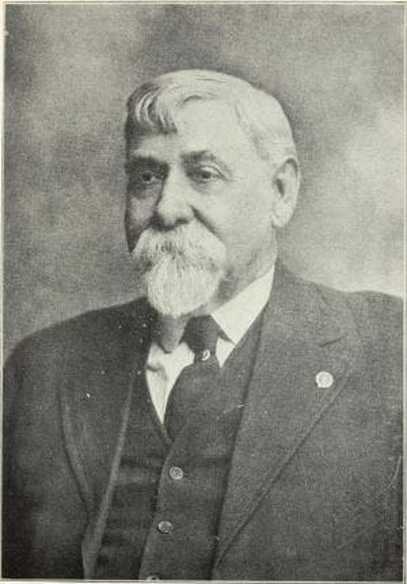 Henry George was Commandant at the Kentucky Confederate Home at the time this story appeared in the Confederate Home Messenger. Photo from "History of the 3d, 7th, 8th and l2th Kentucky C.S.A" written by Henry George and published in May, 1911.
Henry George was Commandant at the Kentucky Confederate Home at the time this story appeared in the Confederate Home Messenger. Photo from "History of the 3d, 7th, 8th and l2th Kentucky C.S.A" written by Henry George and published in May, 1911.
…The Home is a State institution, owned and supported by the State, but it has shown a most neighborly kindness toward the people of the village. They have been allowed and made free use of the drives and passways through the grounds. Churches, schools, clubs and individuals have been allowed free of the hall and piano for entertainments of all kinds, musical, literary, suppers, dances and dancing school. Wagon loads of chairs have been loaned for entertainments outside. When there has been a fire the engines from the Home have quickly responded and at one time prevented the village from being laid in ashes by the response of the Veterans and their fire equipments. (Editor's note: The last reference was to the 1912 fire that started at W.N. Jurey's store, spread to a nearby coal bunker and came close to igniting 10,000 gallons of oil stored nearby. The veterans were the first responders on the scene.)
The Home has been a generous patron of the merchants, dairymen, hucksters, and putting in circulation about one thousand dollars a month in Pewee Valley and its vicinity, a generous free use was made of the telephone at the Home until the telephone manager ordered it to be stopped. The Home purchased a three-cornered lot in the Pewee Valley Cemetery, for which it paid five hundred dollars and placed a very handsome monument on it. The Cemetery Board promised to spend the whole of the five hundred dollars in improving the Cemetery and in making a nice drive along the side of the Confederate lot. There is no evidence of one dollar ever having been spent in this way.
The Home has been a generous patron of the merchants, dairymen, hucksters, and putting in circulation about one thousand dollars a month in Pewee Valley and its vicinity, a generous free use was made of the telephone at the Home until the telephone manager ordered it to be stopped. The Home purchased a three-cornered lot in the Pewee Valley Cemetery, for which it paid five hundred dollars and placed a very handsome monument on it. The Cemetery Board promised to spend the whole of the five hundred dollars in improving the Cemetery and in making a nice drive along the side of the Confederate lot. There is no evidence of one dollar ever having been spent in this way.
Inmates at the Kentucky Confederate Home Sold Souvenirs to Visitors
By the time fire consumed the bulk of the Home’s buildings in the spring of 1920, the opposition’s vanguard had died out, as had many of the Confederate veterans. A report of the fire by Mrs. John L. Woodbury, president of the Albert Sidney Johnston Chapter of the United Daughters of the Confederacy, published in Volume 28 of the Confederate Veteran magazine, showed how much the town’s attitudes toward the Home had softened:
On Thursday, March 25, the greater part of the Confederate Home at Pewee Valley burned. While the loss is great, deep thankfulness is felt that no lives were sacrificed. The fire occurred about as the evening meal was over. Had it been later, no doubt it would have been impossible to save the men, as a high wind was blowing, and the building burned very rapidly.
The commandant of the Home has written me in detail about the loss sustained:
"The main building and the laundry were a total loss, and the roof of the heating plant and one ward of the infirmary burned; the rest of the buildings are intact…
…"The employees of the Home did heroic work in saving the men and property. Too much cannot be said of the citizens of Pewee Valley for their work in behalf of the inmates. The Presbyterian and Episcopal churches were opened for the care of the men. The rector of the Episcopal Church notified me in less than fifteen minutes after the fire started that his church was open for the reception of the men in the infirmary, who were carried there. A great number of the citizens took from one to three inmates to their homes."
It was the Rev. Edward Collins McAllister who opened St. James Episcopal to inmates of the home's infirmary. Located across the railroad tracks at the corner of Maple and Railroad avenues, the little stone church was safely upwind from the raging inferno on the hill. Rev. McAllister's daughter recalled that night and the next morning in a letter to a St. James Parish member recounting her childhood memories of Pewee Valley and reprinted in Thomas Brown's "A Brief History of the Episcopal Parish in Pewee Valley, Kentucky, Part II, 1870-1932 A.D."
One event stands out as tragic in the Valley, and that was the fire that burned the OLD CONFEDERATE HOME, one dark windy night, a fire that lighted the sky for miles. Around the next morning, as I looked down from the Nursery window (in the rectory), I was startled to see the yard full of old men, dazedly ambling about. My Father had brought them there to stay at the church until other arrangements could be made. Staring more closely, I saw that the big seesaw Dad had made for us had been propped up with barrels and lined with basins, and some men were washing up there. I felt very sad that the old Home would no longer be there, nor our old Friends. I recalled the time our Grandmother had taken us to their Silver Anniversary Celebration and how impressed I was by the enormous white cake, decorated with Silver Candy Cannon Balls and Flags. The whole Town was there to greet the men, the sorrowful event of the fire brought the end to an era in the Valley, as the Old Fellows departed.
On Thursday, March 25, the greater part of the Confederate Home at Pewee Valley burned. While the loss is great, deep thankfulness is felt that no lives were sacrificed. The fire occurred about as the evening meal was over. Had it been later, no doubt it would have been impossible to save the men, as a high wind was blowing, and the building burned very rapidly.
The commandant of the Home has written me in detail about the loss sustained:
"The main building and the laundry were a total loss, and the roof of the heating plant and one ward of the infirmary burned; the rest of the buildings are intact…
…"The employees of the Home did heroic work in saving the men and property. Too much cannot be said of the citizens of Pewee Valley for their work in behalf of the inmates. The Presbyterian and Episcopal churches were opened for the care of the men. The rector of the Episcopal Church notified me in less than fifteen minutes after the fire started that his church was open for the reception of the men in the infirmary, who were carried there. A great number of the citizens took from one to three inmates to their homes."
It was the Rev. Edward Collins McAllister who opened St. James Episcopal to inmates of the home's infirmary. Located across the railroad tracks at the corner of Maple and Railroad avenues, the little stone church was safely upwind from the raging inferno on the hill. Rev. McAllister's daughter recalled that night and the next morning in a letter to a St. James Parish member recounting her childhood memories of Pewee Valley and reprinted in Thomas Brown's "A Brief History of the Episcopal Parish in Pewee Valley, Kentucky, Part II, 1870-1932 A.D."
One event stands out as tragic in the Valley, and that was the fire that burned the OLD CONFEDERATE HOME, one dark windy night, a fire that lighted the sky for miles. Around the next morning, as I looked down from the Nursery window (in the rectory), I was startled to see the yard full of old men, dazedly ambling about. My Father had brought them there to stay at the church until other arrangements could be made. Staring more closely, I saw that the big seesaw Dad had made for us had been propped up with barrels and lined with basins, and some men were washing up there. I felt very sad that the old Home would no longer be there, nor our old Friends. I recalled the time our Grandmother had taken us to their Silver Anniversary Celebration and how impressed I was by the enormous white cake, decorated with Silver Candy Cannon Balls and Flags. The whole Town was there to greet the men, the sorrowful event of the fire brought the end to an era in the Valley, as the Old Fellows departed.
Photos from American City magazine, December 1919 Issue Showing the Motor Pumper Fire Truck Sent from Louisville to Fight the Confederate Home Fire
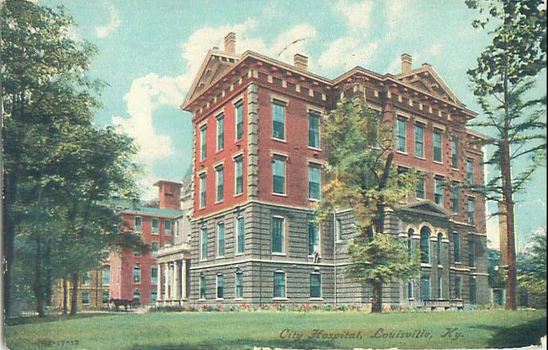 City Hospital in downtown Louisville.
City Hospital in downtown Louisville.
The Courier-Journal’s account the next day noted that the townspeople manned bucket brigades and spent 40 minutes freeing a motorized fire engine pumper brought in from Louisville that had become mired in a ditch and then literally carried it up the hill. They also pitched in with evacuating the inmates in the infirmary.
The March 27, 1920 Courier-Journal reported:
The twenty-six infirmary patients taken to the City Hospital are comfortable. Relatives and friends of some of the men took them into their homes yesterday. The remainder are being cared for in private homes at Pewee Valley, and in temporary quarters arranged at Duke’s Hall and the saved portion of the home’s infirmary building. Major Leathers said last night the people of Pewee Valley had been ‘angels of mercy in the disaster, showing to the world what genuine Kentucky hospitality means.’
However, the day was approaching when H.M. Woodruff, Judge Muir and Harry Weissinger would be vindicated. They were correct in their opposition to the Home.
The March 27, 1920 Courier-Journal reported:
The twenty-six infirmary patients taken to the City Hospital are comfortable. Relatives and friends of some of the men took them into their homes yesterday. The remainder are being cared for in private homes at Pewee Valley, and in temporary quarters arranged at Duke’s Hall and the saved portion of the home’s infirmary building. Major Leathers said last night the people of Pewee Valley had been ‘angels of mercy in the disaster, showing to the world what genuine Kentucky hospitality means.’
However, the day was approaching when H.M. Woodruff, Judge Muir and Harry Weissinger would be vindicated. They were correct in their opposition to the Home.
Related Links
A Visit to the Kentucky Confederate Home in 1915
What Became of the Home
How the Kentucky Confederate Home Wound Up in Pewee Valley
Videos of the 2010 Confederate Memorial Day Observation
The Confederate Burying Ground at Pewee Valley Cemetery
1906 Kentucky Confederate Home Insurance Map
Confederate Hill Map, 2010

